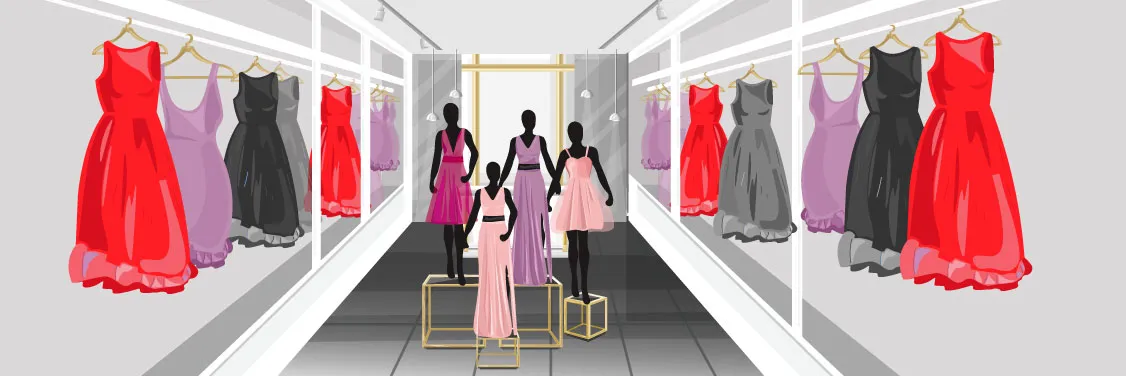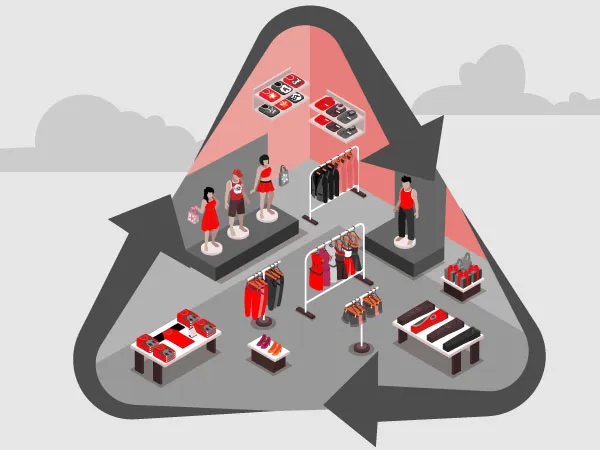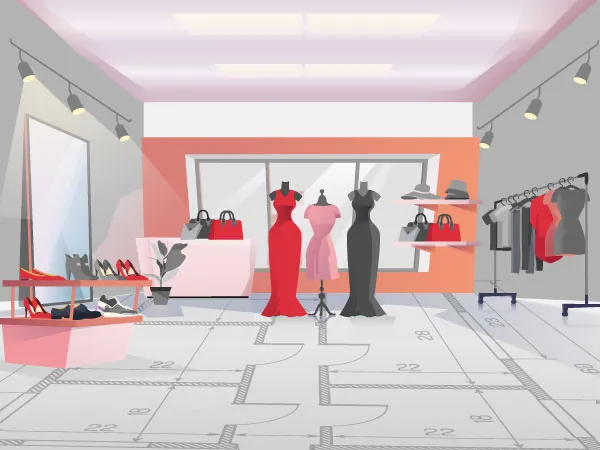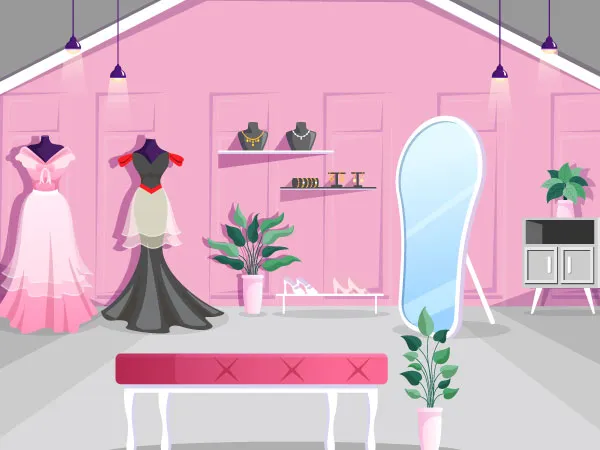ELEVATING CUSTOMER EXPERIENCE WITH BESPOKE LUXURY DESIGN

In the dynamic world of business, interior design remains to be a strategic practice in shaping perceptions and reflecting great brand repute, identity and standing. Having evolved into a sophisticated art in itself, boutique and luxury interior design, with striking characteristics, entails a series of creative practices aimed at crafting astonishing environments. Whether through the personalized charm of boutique design or the lavish opulence of luxury interiors, businesses can elevate their spaces through remarkable conceptualization on the representation of brand identity and foster a sense of absolute sophistication.
As first impressions are paramount to new-age consumers, the ambience of an outlet plays a pivotal role in creating great perceptions around brands. The fusion of boutique and luxury interior design enables businesses to strategically position themselves in the market and communicate commitment to individuality and indulgence to niche audience seeking sophisticated yet personalized experiences. In the changing realm of interior design, the store design concepts continues to evolve, driven by the pursuit of captivating clients.
Boutique interior design transcends the conventional, focusing on creating unique, comforting and personalized spaces tailored to a specific brand or business identity. The essence lies in the details, with a keen emphasis on craftsmanship and individuality. In some cases, businesses seek to combine the bespoke nature of boutique design with the opulence of luxury interiors. This fusion creates a unique synergy that caters to an affluent clientele while maintaining a personalized touch.
Having emerged as a key lifestyle trend shaping luxury commerce since the recession in 2008 and further triggered by the global financial crisis caused by the pandemic, quiet luxury tends to be the new norm for the affluent. With consumers leaning towards minimalism and classics, luxury in the present time is being redefined quite significantly as economic uncertainty, quality and low-key luxury becomes a priority for the new consumers.
As the world of boutique and luxury interior design evolves, the fusion of personalization, sustainability, technology, craftsmanship, multi-sensory experiences, flexibility, cultural influences, and wellness-centric design is shaping the future of interior design for businesses. By staying abreast of the low-key luxury trends and classicism, brands can scale at length while delivering in line with the changing expectations.
Reflecting on some of the key aspects in the world of boutique and luxury interior design, below explored are the factors on how design conceptualisation can elevate business environments, leaving a lasting impact on customers.
Personalization & Brand Identity

Boutique interior design revolves around expressing the brand's identity through thoughtful design elements. Every aspect of the interior, from furnishings to colour schemes, is curated to reflect the brand's personality, creating a cohesive and memorable experience. In the realm of boutique interior design, the era of one-size-fits-all spaces is rapidly fading. In today’s time, brands offer personalized experiences that reflect their brand identity and resonate with their target audience.
Collaborative design processes, where clients actively participate in decision-making, are gaining traction. Tailoring spaces to evoke specific emotions or tell a brand story is becoming a hallmark of successful boutique design.
Luxury interiors are characterized by bespoke elements tailored to the client's preferences. From hand-painted murals to custom-designed furniture, each piece is a work of art, contributing to the overall grandeur of the space. For instance, embracing the new quiet luxury concept and crafting the store as a gallery with a minimalistic outlook, the first flagship store by Khaite in New York, designed by architect Griffin Frazen, reflects a serene yet calm ambience. Combining boutique and luxury elements allows for a tailored sense of exclusivity. Clients can enjoy the personalized touch of boutique design while indulging in the lavishness associated with luxury interiors.
Sustainable Elegance

Luxury is no longer defined solely by opulence; it now encompasses a commitment to sustainability. Brands are increasingly inclined towards biophilic designs, seeking materials and practices that minimize environmental impact without compromising on sophistication.
Integrating sustainable elements, from energy-efficient lighting to recycled materials, not only aligns with corporate responsibility but also enhances the overall appeal of the space. Incorporating the natural elements to create a brilliant fusion of opulence and nature, the new mega-flagship by Chanel in Los Angeles, US, serves as a perfect reference where greenery is central to its elegance, fostering a strong sense of relaxation and peace, turning it into a habitat.
Spatial Efficiency

Unlike generic designs, luxury boutique interiors prioritize spatial efficiency. The layout is meticulously planned to optimize both functionality and aesthetics, ensuring that every square foot serves a purpose while maintaining a visually appealing environment.
As spatial planning for comfort is a non-negotiable aspect of luxury design, the layout must be meticulously planned to ensure ample room for movement and relaxation, creating an environment where clients and guests feel pampered and at ease.
Thoughtfully designed to deliver a premium yet personalised experience across 22,000 sq ft and three floors, the new
flagship by Burberry on New Bond Street, London, provides a pleasant yet comforting exploration experience to the rich and mighty.
Artisanal Craftsmanship

Handcrafted and bespoke elements distinguish boutique interiors. From custom furniture to unique lighting fixtures, the focus on artisanal craftsmanship adds an exclusive touch, setting the business apart from its competitors.
In boutique interior design, there is a growing appreciation for bespoke, handcrafted elements that add a touch of exclusivity. Brands are investing in artisanal craftsmanship, whether it's custom furniture, unique wall finishes, or handwoven textiles.
This emphasis on one-of-a-kind pieces contributes to a sense of authenticity, elevating the overall aesthetic of the space. With respect to the same, the Madison Avenue
boutique in New York by Lanvin, the Paris-based fashion house, blends classical columns and architraves with specially-designed furniture pieces complementing the offerings curation, boasts of a high-degree of artisanal craftmanship by Belgian architect Bernard Dubois. Embracing global influences and cultural diversity is a key trend in both boutique and luxury interior design. Increasingly brands are seeking designs that reflect a global perspective, blending traditional and contemporary elements from different cultures. This fusion not only adds richness to the aesthetic but also communicates a sense of openness and inclusivity.
Technology Integration

Incorporating cutting-edge technology is another hallmark of boutique interior design. From interactive displays to smart lighting systems, technology is seamlessly integrated to enhance the overall user experience, blending the traditional with the contemporary. The integration of cutting-edge technology is transforming luxury interior design. Smart automation, interactive displays, and immersive experiences are becoming integral components of upscale interiors. Brands in collaboration with designers are leveraging technology not just for functionality but also as a design element, seamlessly blending the digital and physical realms to create immersive environments that leave a lasting impression.
Ensuring Elegance

Luxury designs often embrace a timeless aesthetic, steering away from trends that may become outdated. The goal is to create an enduring appeal that withstands the test of time, ensuring the interior remains relevant and stylish for years to come. The well-being of occupants is at the forefront of modern interior design.
Brands are investing in wellness-centric designs that prioritize health and comfort. Incorporating biophilic elements, optimizing natural light, and integrating spaces for relaxation contribute to a holistic approach that enhances both productivity and employee satisfaction. Luxury interior design, on the other hand, is synonymous with opulence and sophistication.
It goes beyond functionality, aiming to create an immersive and indulgent experience for occupants and visitors alike. Perceived as nothing short of a destination reflecting a balanced fusion of awe-inspiring interiors and modish design, the new interconnected store with the existing Haute Parfumerie store on rue Saint-Honoré in Paris by Celine entails a sleek makeover with black and white marble, steel shelving, mirrored surfaces coupled with gilded brass panels and Art Deco-inspired pendant lamps appropriately providing an intimate and exclusive feel to the Very Important Clients (VICs).